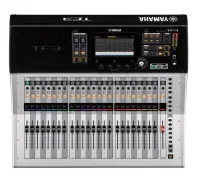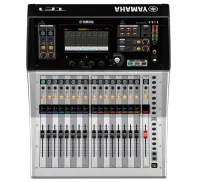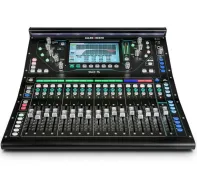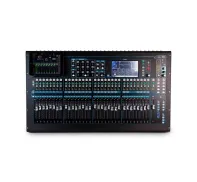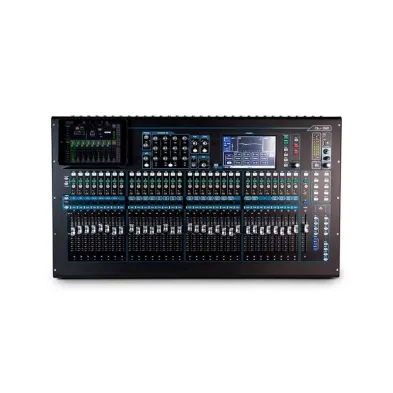
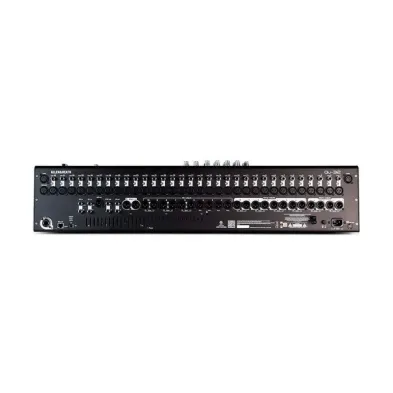
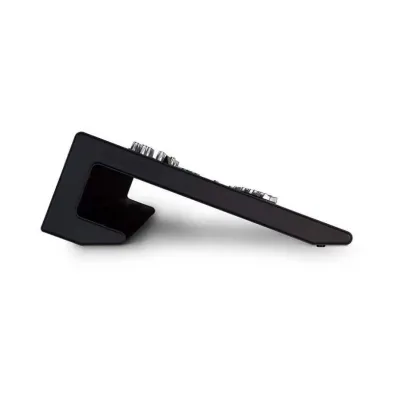
Mixer Qu-32 Allen & Heath
Mixer
Harga
Rp.46,500,000
DESCRIPTION
Allen & Heath QU32 Digital Mixer
With its responsive touchscreen, 33 motor faders and acclaimed AnalogiQTM recallable preamps, Qu-32 combines exceptional ease of use with class-leading audio performance. Drawing on the technologies and workflow pioneered on our GLD and iLive touring systems,
Qu makes Allen & Heath digital mixing more accessible than ever. Qu V1.8 Firmware (scheduled for release in mid-October) adds hot new features, Automatic Mic Mixing,more monitor mixes and a Spectrogram for feedback-hunting. Qu Chrome Edition models also
feature upgraded, high contrast metallic finish controls.
Features
32 Mic / Line Inputs (TRS + XLR)
33 Motor Faders
3 Stereo Inputs (TRS)
24 Mix Outputs (XLR)
4 Stereo Groups (switchable to Mix mode)
Up to 11 Monitor Mixes (4 mono + 7 stereo)*
2 Stereo Matrix Outs
4 DCA Groups
4 Mute Groups
4 FX Engines
4 FX Sends / Returns
10 Soft Keys
32×32 USB Audio Interface
DAW MIDI Control
AES Digital Out
Recallable AnaLOGIQTM Preamps
Qu-Drive direct Multitrack Recording / Playback on USB drives
7” Touchscreen
iLive FX Library
dSNAKETM Remote Audio Port
Automatic Mic Mixer*
Qu-Pad iPad App
Qu-You iPhone / Android personal monitoring app
Compatible with ME Personal Mixing System
Trim, polarity, HPF, gate, insert, 4-band PEQ, compressor and delay on all Inputs
Insert, 4-band PEQ, 1/3 octave GEQ, compressor and delay on all Mix outputs
Built-in Signal Generator
RTA with Peak Band indication
Spectrogram to aid with feedback elimination and taming room acoustics*
High contrast metallic finish controls, matching premium GLD Chrome series
AnalogiQTM Preamps
Qu-32’s thirty two AnalogiQTM total recall preamps feature zero crossing detection and an advanced padless 1dB step gain stage, closely allied to the DSP for optimal gain accuracy and audio transparency. The analogue signal is captured by high class, low latency 24bit analogue to digital converters matched to high quality 24bit digital to analogue converters to deliver the required outputs. The AnalogiQTM design has been refined over many months to offer superb transparency, minimal distortion and an ultra-low noise floor, with a warm, musical sound that is missing from some digital consoles.
The Mixing Experience
Having massive processing power and advanced functionality is great, but it counts for nothing if you can’t access the controls you need in a heartbeat. Once you start using Qu-32 you’ll sense the years of research into ergonomics and the hands-on mixing experience that our team has drawn upon to deliver a wonderfully natural layout and workflow. It’s not about recreating an analogue interface, it’s about creating an experience that’s fluid, comfortable and intuitive for novices, digital natives and old school road warriors alike, making all the benefits of digital mixing technology readily accessible to all. High contrast metallic finish controls complete the picture, offering excellent low light visibility and enhanced tactile control.
Touch Control
The 7”, 800 x 480, sixteen million colour Touchscreen and its dedicated data encoder form the heart of the Qu interface, providing super-fast, easy access to all settings. The user-friendly interface has been designed with clarity in mind. Dedicated keys and screen tabs quickly guide you to meter and RTA views, FX racks, channel processing, USB audio control, scenes, setup menus and much more.
The SuperStrip
All your key processing tools are presented in a clean layout on the SuperStrip, with 1 function per physical control. The SuperStrip is complemented by an onscreen Touch Channel for intuitive access to full processing parameters without clutter or complex menu structures. Processing for Mono and Stereo inputs includes trim, polarity, HPF, gate, insert, 4 band PEQ, compressor and delay. The main LR and the Mono mixes have controls for Insert, 1/3 octave GEQ, compressor and delay. The Stereo mixes provide Insert, 4-band PEQ, compressor, delay and balance control.
Fader Automation
Moving faders started as an expensive option in the studio desks of the 80s, and later became the norm with the advent of digital technology. Nevertheless some entry-level digital mixers lack this precious commodity which is a fundamental part of the Total Recall approach. Fader automation is essential for rapid mixing, especially when you’re dealing with multiple monitor mixes – just press a mix key and the faders immediately fly to the send levels for that mix. Qu-32 features 33 motorized ALPS faders, 32 arranged over 2 layers, allowing instant access to all channels and masters in a compact space, plus a dedicated master fader which dynamically follows the mix selection. A third, Custom layer is available for ad-hoc user strip layout, where any combination of Inputs, FX Sends, FX Returns and Mix masters can be assigned.
iLive FX
Qu-32’s dynamics and FX algorithms are derived from the FX used in our iLive pro touring series. Some of the world’s most respected audio engineers have chosen to use iLive’s FX on tour in preference to top-end plug-ins and external FX units. Qu-32 boasts 4 stereo iLive FX engines, featuring lovingly crafted emulations of legendary classic reverbs, gated reverbs, delays, modulators, flangers and more. The FX library has the ability to grow with future firmware releases. FX are returned to the mix on dedicated return channels, so you’re not tying up your mono and stereo input channels. Each Stereo FX Return has a dedicated 4 band PEQ.
Total Recall
True digital mixing is about being able to save and recall scenes (snapshots) at the press of a button. Qu can store up to 100 full Scenes for recall at will. Channels and mixes can be made Safe from Scene recall. For example, if an instrument or mic gets swapped out after the soundcheck, the channel can be made safe to avoid settings being overridden by Scene recalls. Or if a broadcast feed or walk-in iPod is added last-minute before the show kicks off, that mix or channel can be made safe from any scene change. In addition, single parameter updates can be blocked using a Recall Filter. So if you tweak the graphic EQ to reflect the room response when the audience gets in, you can block this to prevent any overwriting at scene change.
Custom settings for each EQ, compressor or channel can be saved as Library presets. This lets you store your tried and tested setting for your favourite vocal mic or reverb pattern and apply it to other channels or shows. Libraries, Scenes and the complete Show configuration can be saved to a USB key, so you can carry the show with you, ready to use on another Qu mixer.
Automatic Mic Mixer (AMM)
AMM is vital in applications such as conferences, meetings and panel discussions where a number of microphones are open at the same time, reducing background noise and minimising the risk of feedback. The Automatic Microphone Mixer feature helps the engineer to manage the levels of multiple mic inputs, ensuring that each speaker’s contribution is heard. Our D-Classic dynamic gain sharing algorithm is inspired by industry standard automixers. Up to 16 microphone sources can be mixed at once, with each channel having a priority setting which determines its ‘weight’ in the total system gain.
USB Audio Streaming
Qu-32’s built-in interface streams multitrack audio to your Mac or Windows computer. Any combination of Inputs and Mixes can be patched to the USB interface. The returns from the computer can be assigned to the Input channels. The interface is class-compliant on Mac OS X – which means it’s truly plug ‘n play, with no need to install a driver. An ASIO / WDM driver is available for Windows computers.
Standard MIDI control is tunnelled over the USB connection so you can easily map the faders to the tracks of your favourite DAW. Additionally, the DAW Control driver for Mac OS X enables better DAW integration via HUI or Mackie Control emulation.
Qu-Drive
Forget soundcard drivers and software setup, Qu-32 has an integrated multitrack USB recorder, providing 18 channels of 48kHz 24bit recording and playback straight to / from your USB hard drive. Capturing multitrack recordings of your shows has never been so easy, and multitrack audio can be played back to the Mono Input channels 1-18. On top of this, Qu-Drive also provides stereo recording, patchable from any pair of Mix outputs, the Main LR (pre, post, or summed to mono) or even the PAFL bus, with 2- track stereo playback to ST3.
ARMed to the Hilt
Qu-32 is equipped with 5 cores of high efficiency ARM core processing, with dedicated ARM cores running the touchscreen display and surface, USB streaming, Qu-Drive multi-channel USB recording / playback, Ethernet and fader automation. Between them the ARM cores provide state-of-the-art processing, working in parallel to deliver extensive control, instant-on operation, and lightning-fast response.
The mixer’s DSP farm exploits next generation dual core DSPs. The Qu DSP architecture employs varied bit depths, tailored to specific algorithms, with 48 bits on critical EQ functions and a 56 bit accumulator on the mix bus where it really counts, allowing every nuance of the audio to be captured in the final mix.
The Shape of Things to Come
Made from 18 gauge, cold-rolled Zintec steel, Qu32’s distinctive frame is designed for strength and rigidity. We’ve done unspeakable things to that chassis in the lab and it’s taken everything we’ve thrown at it – even being stomped on by our resident ex-tank commander.
Silence is a precious commodity in the live or studio environment, which is why nobody wants those moments of stillness ruined by the whirring of fans coming from the mix position. Qu’s sleek profile generates optimal airflow through the mixer, eliminating the need for any fans.
Qu-Pad
Add the Qu-Pad iPad app to your Qu setup and you’re free to adjust the monitors on stage, roam around the venue whilst tweaking the PA, and then mix the show from the heart of the audience. Qu-Pad connects to the mixer over Wi-Fi and gives instant access to all live mixing parameters and settings. Qu-Pad requires the connection of a Wi-Fi router or access point to the Qu-32 Network port.
ME Personal Mixing System
Qu-32 is fully compatible with our ME Personal Mixing System. Any number of ME-1 personal mixers can be chained from the dSNAKETM port (or from an AR2412 Stagebox if you’ve got one connected to the dSNAKETM port). Each performer can be given tailored control over their own mix, leaving the engineer free to focus on the audience experience.
Allen & Heath QU32 Digital Mixer
With its responsive touchscreen, 33 motor faders and acclaimed AnalogiQTM recallable preamps, Qu-32 combines exceptional ease of use with class-leading audio performance. Drawing on the technologies and workflow pioneered on our GLD and iLive touring systems,
Qu makes Allen & Heath digital mixing more accessible than ever. Qu V1.8 Firmware (scheduled for release in mid-October) adds hot new features, Automatic Mic Mixing,more monitor mixes and a Spectrogram for feedback-hunting. Qu Chrome Edition models also
feature upgraded, high contrast metallic finish controls.
Features
32 Mic / Line Inputs (TRS + XLR)
33 Motor Faders
3 Stereo Inputs (TRS)
24 Mix Outputs (XLR)
4 Stereo Groups (switchable to Mix mode)
Up to 11 Monitor Mixes (4 mono + 7 stereo)*
2 Stereo Matrix Outs
4 DCA Groups
4 Mute Groups
4 FX Engines
4 FX Sends / Returns
10 Soft Keys
32×32 USB Audio Interface
DAW MIDI Control
AES Digital Out
Recallable AnaLOGIQTM Preamps
Qu-Drive direct Multitrack Recording / Playback on USB drives
7” Touchscreen
iLive FX Library
dSNAKETM Remote Audio Port
Automatic Mic Mixer*
Qu-Pad iPad App
Qu-You iPhone / Android personal monitoring app
Compatible with ME Personal Mixing System
Trim, polarity, HPF, gate, insert, 4-band PEQ, compressor and delay on all Inputs
Insert, 4-band PEQ, 1/3 octave GEQ, compressor and delay on all Mix outputs
Built-in Signal Generator
RTA with Peak Band indication
Spectrogram to aid with feedback elimination and taming room acoustics*
High contrast metallic finish controls, matching premium GLD Chrome series
AnalogiQTM Preamps
Qu-32’s thirty two AnalogiQTM total recall preamps feature zero crossing detection and an advanced padless 1dB step gain stage, closely allied to the DSP for optimal gain accuracy and audio transparency. The analogue signal is captured by high class, low latency 24bit analogue to digital converters matched to high quality 24bit digital to analogue converters to deliver the required outputs. The AnalogiQTM design has been refined over many months to offer superb transparency, minimal distortion and an ultra-low noise floor, with a warm, musical sound that is missing from some digital consoles.
The Mixing Experience
Having massive processing power and advanced functionality is great, but it counts for nothing if you can’t access the controls you need in a heartbeat. Once you start using Qu-32 you’ll sense the years of research into ergonomics and the hands-on mixing experience that our team has drawn upon to deliver a wonderfully natural layout and workflow. It’s not about recreating an analogue interface, it’s about creating an experience that’s fluid, comfortable and intuitive for novices, digital natives and old school road warriors alike, making all the benefits of digital mixing technology readily accessible to all. High contrast metallic finish controls complete the picture, offering excellent low light visibility and enhanced tactile control.
Touch Control
The 7”, 800 x 480, sixteen million colour Touchscreen and its dedicated data encoder form the heart of the Qu interface, providing super-fast, easy access to all settings. The user-friendly interface has been designed with clarity in mind. Dedicated keys and screen tabs quickly guide you to meter and RTA views, FX racks, channel processing, USB audio control, scenes, setup menus and much more.
The SuperStrip
All your key processing tools are presented in a clean layout on the SuperStrip, with 1 function per physical control. The SuperStrip is complemented by an onscreen Touch Channel for intuitive access to full processing parameters without clutter or complex menu structures. Processing for Mono and Stereo inputs includes trim, polarity, HPF, gate, insert, 4 band PEQ, compressor and delay. The main LR and the Mono mixes have controls for Insert, 1/3 octave GEQ, compressor and delay. The Stereo mixes provide Insert, 4-band PEQ, compressor, delay and balance control.
Fader Automation
Moving faders started as an expensive option in the studio desks of the 80s, and later became the norm with the advent of digital technology. Nevertheless some entry-level digital mixers lack this precious commodity which is a fundamental part of the Total Recall approach. Fader automation is essential for rapid mixing, especially when you’re dealing with multiple monitor mixes – just press a mix key and the faders immediately fly to the send levels for that mix. Qu-32 features 33 motorized ALPS faders, 32 arranged over 2 layers, allowing instant access to all channels and masters in a compact space, plus a dedicated master fader which dynamically follows the mix selection. A third, Custom layer is available for ad-hoc user strip layout, where any combination of Inputs, FX Sends, FX Returns and Mix masters can be assigned.
iLive FX
Qu-32’s dynamics and FX algorithms are derived from the FX used in our iLive pro touring series. Some of the world’s most respected audio engineers have chosen to use iLive’s FX on tour in preference to top-end plug-ins and external FX units. Qu-32 boasts 4 stereo iLive FX engines, featuring lovingly crafted emulations of legendary classic reverbs, gated reverbs, delays, modulators, flangers and more. The FX library has the ability to grow with future firmware releases. FX are returned to the mix on dedicated return channels, so you’re not tying up your mono and stereo input channels. Each Stereo FX Return has a dedicated 4 band PEQ.
Total Recall
True digital mixing is about being able to save and recall scenes (snapshots) at the press of a button. Qu can store up to 100 full Scenes for recall at will. Channels and mixes can be made Safe from Scene recall. For example, if an instrument or mic gets swapped out after the soundcheck, the channel can be made safe to avoid settings being overridden by Scene recalls. Or if a broadcast feed or walk-in iPod is added last-minute before the show kicks off, that mix or channel can be made safe from any scene change. In addition, single parameter updates can be blocked using a Recall Filter. So if you tweak the graphic EQ to reflect the room response when the audience gets in, you can block this to prevent any overwriting at scene change.
Custom settings for each EQ, compressor or channel can be saved as Library presets. This lets you store your tried and tested setting for your favourite vocal mic or reverb pattern and apply it to other channels or shows. Libraries, Scenes and the complete Show configuration can be saved to a USB key, so you can carry the show with you, ready to use on another Qu mixer.
Automatic Mic Mixer (AMM)
AMM is vital in applications such as conferences, meetings and panel discussions where a number of microphones are open at the same time, reducing background noise and minimising the risk of feedback. The Automatic Microphone Mixer feature helps the engineer to manage the levels of multiple mic inputs, ensuring that each speaker’s contribution is heard. Our D-Classic dynamic gain sharing algorithm is inspired by industry standard automixers. Up to 16 microphone sources can be mixed at once, with each channel having a priority setting which determines its ‘weight’ in the total system gain.
USB Audio Streaming
Qu-32’s built-in interface streams multitrack audio to your Mac or Windows computer. Any combination of Inputs and Mixes can be patched to the USB interface. The returns from the computer can be assigned to the Input channels. The interface is class-compliant on Mac OS X – which means it’s truly plug ‘n play, with no need to install a driver. An ASIO / WDM driver is available for Windows computers.
Standard MIDI control is tunnelled over the USB connection so you can easily map the faders to the tracks of your favourite DAW. Additionally, the DAW Control driver for Mac OS X enables better DAW integration via HUI or Mackie Control emulation.
Qu-Drive
Forget soundcard drivers and software setup, Qu-32 has an integrated multitrack USB recorder, providing 18 channels of 48kHz 24bit recording and playback straight to / from your USB hard drive. Capturing multitrack recordings of your shows has never been so easy, and multitrack audio can be played back to the Mono Input channels 1-18. On top of this, Qu-Drive also provides stereo recording, patchable from any pair of Mix outputs, the Main LR (pre, post, or summed to mono) or even the PAFL bus, with 2- track stereo playback to ST3.
ARMed to the Hilt
Qu-32 is equipped with 5 cores of high efficiency ARM core processing, with dedicated ARM cores running the touchscreen display and surface, USB streaming, Qu-Drive multi-channel USB recording / playback, Ethernet and fader automation. Between them the ARM cores provide state-of-the-art processing, working in parallel to deliver extensive control, instant-on operation, and lightning-fast response.
The mixer’s DSP farm exploits next generation dual core DSPs. The Qu DSP architecture employs varied bit depths, tailored to specific algorithms, with 48 bits on critical EQ functions and a 56 bit accumulator on the mix bus where it really counts, allowing every nuance of the audio to be captured in the final mix.
The Shape of Things to Come
Made from 18 gauge, cold-rolled Zintec steel, Qu32’s distinctive frame is designed for strength and rigidity. We’ve done unspeakable things to that chassis in the lab and it’s taken everything we’ve thrown at it – even being stomped on by our resident ex-tank commander.
Silence is a precious commodity in the live or studio environment, which is why nobody wants those moments of stillness ruined by the whirring of fans coming from the mix position. Qu’s sleek profile generates optimal airflow through the mixer, eliminating the need for any fans.
Qu-Pad
Add the Qu-Pad iPad app to your Qu setup and you’re free to adjust the monitors on stage, roam around the venue whilst tweaking the PA, and then mix the show from the heart of the audience. Qu-Pad connects to the mixer over Wi-Fi and gives instant access to all live mixing parameters and settings. Qu-Pad requires the connection of a Wi-Fi router or access point to the Qu-32 Network port.
ME Personal Mixing System
Qu-32 is fully compatible with our ME Personal Mixing System. Any number of ME-1 personal mixers can be chained from the dSNAKETM port (or from an AR2412 Stagebox if you’ve got one connected to the dSNAKETM port). Each performer can be given tailored control over their own mix, leaving the engineer free to focus on the audience experience.
RELATED PRODUCTS
>Warehouse Bekasi
Jln. Bacang Raya, Pekayon Jaya - Bekasi Selatan
+62 812 8787 2722
Senin - Sabtu : 09.00 - 17.00
Senin - Sabtu : 09.00 - 17.00
Store Karawang
Jln. Tuparev, Nagasari - Karawang Barat
Senin - Minggu : 08.00 - 20.00
Senin - Minggu : 08.00 - 20.00
Store Karawang 2
Jln. A.R. Hakim, Nagasari - Karawang Barat
Senin - Minggu : 08.00 - 18.00
Senin - Minggu : 08.00 - 18.00

